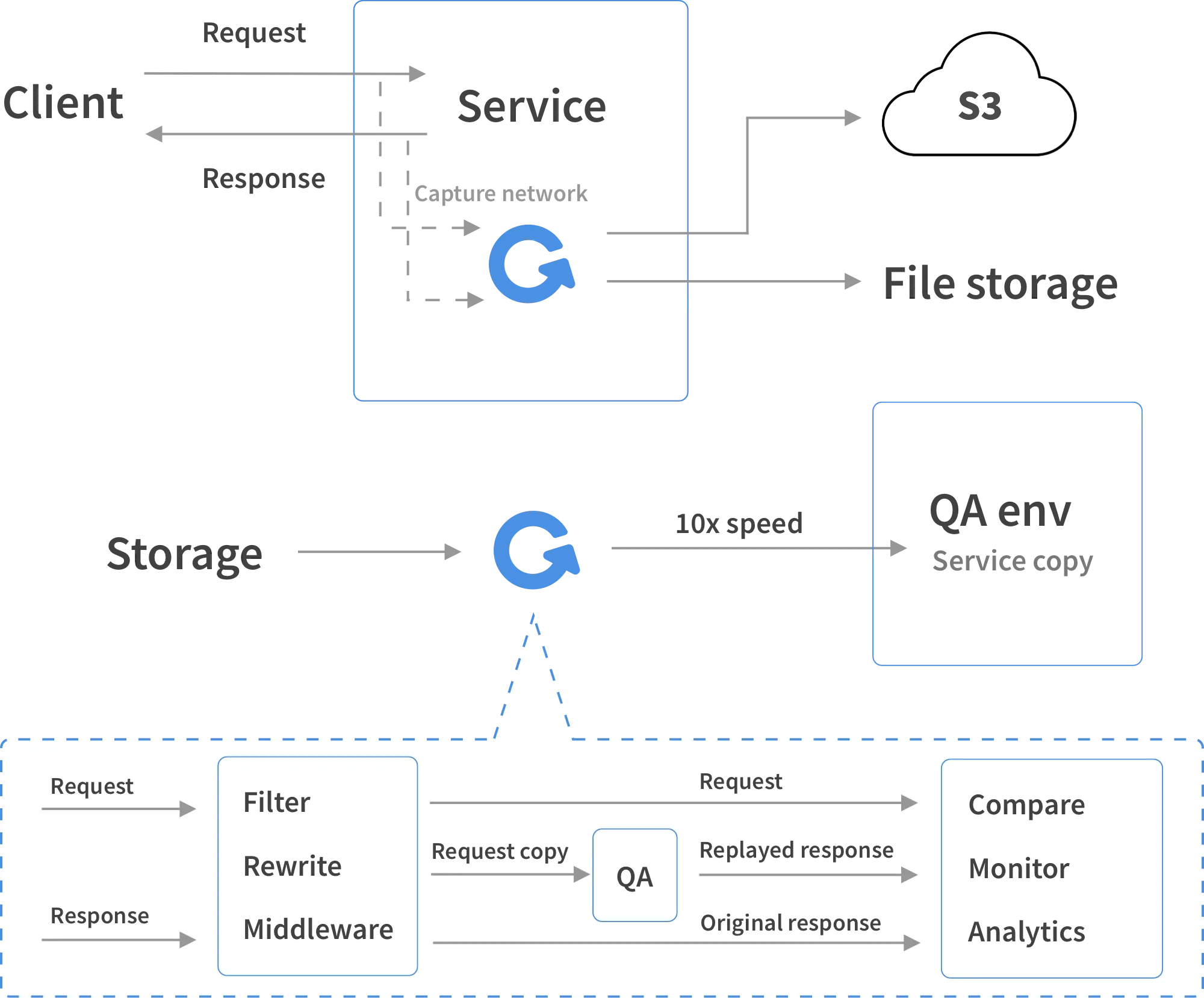Beyond Synthetic Load Testing
Why simulate when you can replay real production traffic? Get authentic performance insights with the exact user patterns your applications experience in the wild.
gor --input-file "requests.gor|200%" --output-http="http://staging.example.com"

Real Production Traffic
Capture and replay actual user behavior, browser patterns, and robot interactions for precise load tests.
Dynamic Request Modification
Modify requests on the fly with built-in features or custom plugins to simulate different scenarios.
Distributed Testing
Scale horizontally with a master-slave architecture for large-scale or complex load testing campaigns.
Real Traffic Load Testing Simplified
Eliminate the complexity of building synthetic test scenarios. Instead, capture and replay the real traffic that hits your production environment.
Record Traffic
Capture live production patterns (including TCP sessions) to replicate real user experiences.
Configure Replay
Set replay speed, customize request modifications, and fine-tune concurrency levels.
Execute Test
Deploy across distributed nodes for advanced, large-scale load testing of your application.
Plan Infrastructure
Leverage real data to make informed scaling decisions for on-premise or cloud environments.
Why Real Traffic Load Testing Matters
Synthetic tests can’t match the nuance and complexity of actual user behavior—especially for demanding or microservice-driven workloads.
Exact Traffic Replication
Maintain precise request timing, order, frequency, and complete TCP session fidelity for unbeatable realism.
Flexible Speed Control
Speed up or slow down traffic flow to match your unique performance testing requirements.
Infrastructure Planning
Accurately estimate resource requirements and budget for your next big launch or traffic spike.
Complete Session Fidelity
Preserve headers, content sizes, and user flow patterns to identify real-world bottlenecks.
Leverage the Power of Go/Golang
GoReplay is built in Go, offering high performance and straightforward concurrency. Here’s why that’s valuable for load testing:
Lightweight and Efficient
The Go language is designed to handle massive concurrency. GoReplay naturally benefits from Go’s efficient memory usage and speed, allowing you to replay real-world traffic without overwhelming system resources.
Ideal for Modern Architectures
Whether you’re running microservices, containers, or serverless functions, Go’s simplicity and concurrency features ensure that your load testing remains smooth, reliable, and scalable.
Frequently Asked Questions
Answers to common questions about GoReplay, load testing, and more.
How does GoReplay differ from synthetic load testing tools?
Most synthetic load testing tools rely on recorded scripts or artificially generated traffic. GoReplay captures real traffic from production environments, preserving authentic user journeys, TCP sessions, and request flows—giving you the most accurate and reliable test data possible.
Can I scale GoReplay to test very high traffic volumes?
Absolutely. By deploying multiple GoReplay nodes with a master-slave setup, you can simulate extremely high traffic volumes that mirror peak production loads. This is especially useful for applications designed to handle thousands—or even millions—of requests per second.
What if I need to modify requests during replay?
GoReplay includes built-in request modification features, and you can extend it through custom plugins. This allows you to test scenarios like changing headers, adjusting payloads, or re-routing traffic, ensuring you can explore any edge cases or performance constraints.
Is GoReplay suitable for distributed load testing?
Yes. Its architecture supports distributed load testing across multiple nodes, allowing you to accurately replicate traffic patterns in more complex environments. This flexibility helps you identify and address bottlenecks before they impact real users.
Start Testing with Real Traffic
Unlock accurate, actionable performance data—no more guesswork. Run your load testing the way it was meant to be done: with real user traffic.
